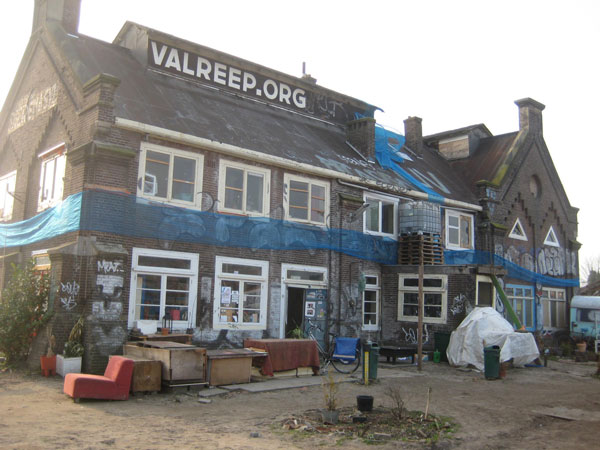Our man in Amsterdam
By Michael Marchman
In October 2010, squatting became illegal in the Netherlands. In the US, where private property rights are so sacrosanct as to be virtually unquestionable, the thought that a person might have the legal right to make their home in or on someone else’s unused property is probably enough to make most peoples’ heads explode. But for most of the past fifty years, squatting was, under certain conditions, entirely legal and squatters (krakers in Dutch) enjoyed full legal protection.

this Amsterdam squat recently screened Squatted Freedom and hosted a talk by Michael Hardt. Photo by Michael Marchman
The right to take over an abandoned building and to legally claim it as your home, art studio, bar or community center, is one of the conditions (along with legalized prostitution and soft drugs, of course) that has given rise to the Netherlands’, and in particular, Amsterdam’s international image as a place of tolerance and unparalleled individual freedom. (Or, if you are a devotee of Fox News’s The O’Reilly Factor, as “a cesspool of corruption, crime [where] everything is out of control. It’s anarchy!”).
The history of squatting in the Netherlands reaches back to the period of World War I. The first law protecting the rights of squatters dates to 1914 when it was made illegal to evict someone from a piece of property if they had a bed, a table, and a chair. This law was widely invoked during the great international economic crisis of the 1930s when large numbers of people were unable to pay their rent and were being thrown out of their homes.
In the 1960s, the squatters’ movement emerged as part of a broader, radical political movement led, in Amsterdam, by Provo, a group of anarchists operating in the Situationist vein. They combined absurdist humor and non-violent provocations of the police to stimulate radical social and political change. (Check out the extremely interesting entry on the Provo movement on Wikipedia).
But the squatters’ movement was also a direct response to a very concrete social and economic problem. The post-war baby-boom generation was reaching adulthood and moving out of their parents’ homes. What they encountered seemed contradictory. On the real estate market, a tremendous housing shortage in Amsterdam (still the case) and throughout the Netherlands kept rents high. At the same time, a large number of vacant and abandoned properties sat unused. Young Amsterdammers, frustrated by the lack of affordable housing and radicalized by the charged atmosphere of the era, began taking over empty buildings, furnishing them with a bed, a table, and one chair. Once in and legally protected from eviction, squatters set to fixing up their new homes to make them suitable for living.
Squatting has been an important thread in the urban fabric of the Netherlands ever since. Some squats are now decades old and a number of former squatters have acquired legal titles to their squats. Buildings are not only squatted for living purposes, many squats function as community art and political centers and as venues for live music and other events.
In 2010, however, a right-wing government came to power in the Netherlands and squatting was promptly banned across the country. The last year and a half has seen the eviction of dozens of (formerly legal) squats or kraks—usually by baton-wielding riot police. Often these evictions involve streets battles between squatters and cops. Many squats have already been successfully evicted and as the authorities continue to crack down the future of the squatters’ movement in the Netherlands is uncertain.




1 Pingback